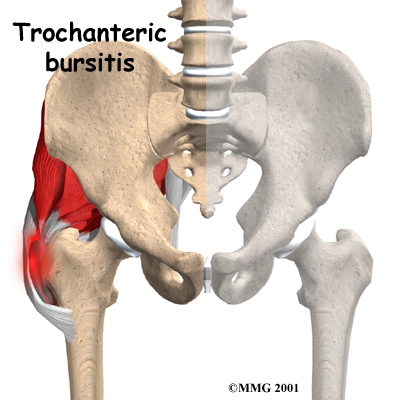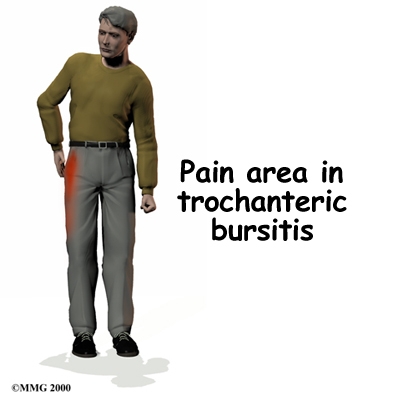A Patient's Guide to Trochanteric Bursitis of the Hip

Introduction
In many areas of the body, muscles and tendons must slide over and against one another during movement. At each of these places, a small sac of lubricating fluid helps the muscles and tendons move properly. Usually these sacs of fluid, called bursae, function to reduce friction, but if they become swollen and irritated they can cause pain.
One common area where this occurs is in the bursa on the outside of the hip, called the trochanteric bursa. This creates a condition known as trochanteric bursitis. This condition is common in older individuals. It may also occur in younger patients who are extremely active in exercises such as walking, running, or biking.
This guide will help you understand
- how trochanteric bursitis develops
- how doctors diagnose the condition
- what treatments are available
Chiropractic Treatment
Trochanteric bursitis is often treated successfully with chiropractic care. Chiropractic adjustments/manipulations are performed to help restore normal biomechanics to the hip joint. This is where chiropractic manipulation has an advantage over other specialties. It is important to manipulate and stretch capsular joint restrictions during the treatment phase. Chiropractors use hands on treatment and stretching to help restore full hip range of motion. Improving strength and coordination in the buttock and hip muscles also enables the femur to move in the socket smoothly and can help reduce friction on the bursa. You may need chiropractic treatments for four to six weeks before full motion and function return.
Younger patients who have this condition because of overuse can usually be treated by reducing their activity or changing the way they do their activity. Combining this with an exercise program of stretching and strengthening and various modalities such as ice, electrical muscle stimulation, heat and ultrasound.
Many Practitioners frequently overlook the feet when examining the hip. The feet should always be checked for poor or faulty biomechanics. The feet are the foundation of the body and many foot conditions eventually contribute to knee, hip and lower back problems. Orthotics for your shoes and/or sneakers will have a significant effect in reducing excessive biomechanical forces on the hip. At the Winchester Hospital Chiropractic Center, we can take molds of your feet and fit you for custom made orthotics.
Anatomy
Where is the trochanteric bursa, and what does it do?
The hip joint is one of the true ball-and-socket joints of the body. The hip socket is called the acetabulum and forms a deep cup that surrounds the ball of the upper thigh bone (femur), or femoral head. The hip is surrounded by the thick muscles of the buttock at the back and the thick muscles of the thigh in the front.
On the outside of the upper end of the femur is a large bump called the greater trochanter. This bump is the point where the large buttock muscles that move the hip connect to the femur. These muscles help rotate and move the hip outward. Another layer of muscle slides over this bump and attaches lower down on the femur. This is the largest muscle of the buttock called the gluteus maximus.
Where friction must occur between muscles, tendons, and bones there is usually a structure called a bursa. A bursa is a thin sac of tissue that contains a bit of fluid to lubricate the area where the friction occurs. The bursa is a normal structure, and the body will even produce a bursa in response to friction.
Causes
Why do I have this problem?
Sometimes a bursa can become inflamed (swollen and irritated) because of too much friction or because of an injury to the bursa. An inflamed bursa can cause pain because movement makes the structures around the bursa rub agaisnt it.
Friction can build in the bursa during walking if the long tendon on the side of the thigh is tight. It is unclear what causes this tightening of the tendon. The gluteus maximus attaches to this long tendon. As you walk, the gluteus maximus pulls this tendon over the greater trochanter with each step. When the tendon is tight, it rubs against the bursa. The rubbing causes friction to build in the bursa, leading to irritation and inflammation. Friction can also start if the outer hip muscle (gluteus medius) is weak, if one leg is longer than the other, or if you run on banked surfaces.
Most cases of trochanteric bursitis appear gradually with no obvious underlying injury or cause. Trochanteric bursitis can occur after artificial replacement of the hip joint or other types of hip surgery. The cause may be a combination of changes in the way the hip works, the way it is aligned, or the way scar tissue has formed from the healing incision.
A fall on the hip can cause bleeding into the bursa. The bleeding is not serious, but the bursa may react to the blood by becoming inflamed. The inflammation causes the bursa to become thickened over time. This thickening, constant irritation, and inflammation may result in the condition becoming chronic, or long lasting.
Symptoms
What does the condition feel like?
The first symptom of trochanteric bursitis is usually pain. The pain can be felt in the area of the hip right over the bump that forms the greater trochanter. Eventually the pain may radiate down the outside of the thigh. As the problem progresses, the symptoms include development of a limp when walking and stiffness in the hip joint. Eventually, the pain will also be present at rest and may even cause a problem with sleeping.

Diagnosis
How do doctors identify the problem?
The diagnosis of trochanteric bursitis begins with a history and physical examination. In fact, this is usually all that is necessary to make the diagnosis. Your doctor will want to know when the pain began and which motions cause the pain. A physical examination will be done to determine how much stiffness you have in the hip and if you have a limp. Once this is done, X-rays will most likely be ordered to make sure that there are no other abnormalities in the hip.
X-rays
X-rays will usually not show trochanteric bursitis. If X-rays are suggested they are to rule out other problems that may be causing your hip pain. Sometimes it is difficult to tell for certain whether the pain you are suffering is from trochanteric bursitis or underlying arthritis of the hip joint. An X-ray may give more information about the condition of the hip joint itself.
All content provided by eORTHOPOD® is a registered trademark of Medical Multimedia Group, L.L.C.. Content is the sole property of Medical Multimedia Group, L.L.C.. and used herein by permission.
All materials from eORTHOPOD® are the sole property of Medical Multimedia Group, L.L.C.. and are used herein by permission. eORTHOPOD® is a registered trademark of Medical Multimedia Group, L.L.C..
|